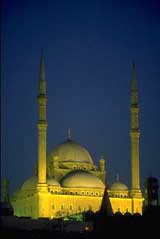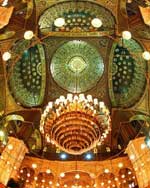|
The Citadel
 The Citadel is the natural focus of a visit to Islamic Cairo. It
represents the most dramatic feature of Cairo’s skyline: a
centuries-old bastion crowned by the needle-like minarets of the
Great Mosque of Mohamed Ali, This fortified complex was begun by
Salah El- Din, the founder of the Ayyubid dynasty. Slah El-Din
reign (1171-93) saw much fortification of the city, though it
was his nephew, Al-Kamil , who developed the Citadel as a royal
residence, later to be replaced by the palaces of Sultan Al
Nasir. The Citadel is the natural focus of a visit to Islamic Cairo. It
represents the most dramatic feature of Cairo’s skyline: a
centuries-old bastion crowned by the needle-like minarets of the
Great Mosque of Mohamed Ali, This fortified complex was begun by
Salah El- Din, the founder of the Ayyubid dynasty. Slah El-Din
reign (1171-93) saw much fortification of the city, though it
was his nephew, Al-Kamil , who developed the Citadel as a royal
residence, later to be replaced by the palaces of Sultan Al
Nasir.
The main features of the Citadel as it is today, however , are
associated with Mohammd Ali, a worthy successor to the Mamlukes
and Turks. In 1811 he feasted 470 leading Mamluks in the Citadel
palace, bade them farewell with honours, then had them ambushed
in the sloping lane behind the Bab al-Azab, the locked gate
opposite to the Akhur Mosque.
Nowadays the main entrance to the Citadel is at a higher level,
closer to the centre of the complex. There is superb view of the
entire city from the Citadel’s terrace
 Mohammed Ali’s Mosque Mohammed Ali’s Mosque
Designed by the Greek architect Yussuf Bushnaq, The Mohammad Ali
(Alabaster) Mosque in the Citadel was begun in 1830 (finished in
1857) in the Ottoman style by Mohammad Ali Pasha, ruler of
Egypt, and founder of the Country's last dynasty of Khedives and
Kings.
The mosque is the Tomb of Mohammad Ali and is also known
as the alabaster Mosque because of the extensive use of this
fine material from Beni Suef. It's two slender 270 foot minarets
are unusual for Cairo. From the arcaded courtyard, visitors have
a magnificent view across the city to the Pyramids in Giza. Just
off the courtyard is the vast prayer hall with an Ottoman style
dome which is 170 feet above. The parapet to the southwest
offers a good view of the Sultan Hassan and Ibn Tulun Mosques
and of Cairo itself. Perhaps because of it's location, it is one
of the most frequented Mosques by tourists. |